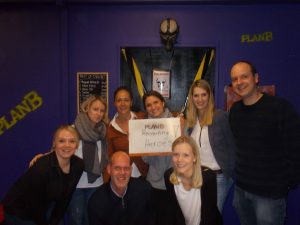The 10 escape room alternatives for the escape game of the future
The secret to delight guests = Integrate fresh, fun, challenging puzzles into a compelling story.
Maybe you already know that?
But what happens when other providers open an escape game near you, and they already know the secret?
Well, you can continue in the hope that your customer service, competitive prices and positive reviews will keep you afloat.
Or you can look at the trends, consider the direction the industry is taking and try something that no one in your city or region has ever dared to do before. How is the funtainment industry developing and how can you set a trend?
Read on and get ready for the future of the Escape Room!
While escape dreams are gaining popularity around the world, fans are demanding more and more creativity and challenges from escape room operators.
When the Live Escape Rooms started their triumphal march about 10 years ago, they were a new, exciting form of entertainment, and players were impressed by the concept.
The format itself was so new that the design of the escape game was often a secondary concern. That doesn’t mean that the early Escape Rooms were badly designed, but in a market with little competition, any escape room was a big deal, regardless of scenario, decoration, and other factors that are now increasingly a priority.
Today, people who know the Escape Room experience and the mechanism of “unlocking a box to find another clue that leads to the code to unlock another box, etc.” have the need to go to the next level of difficulty in Escape Game.
Unfortunately, not all providers of live escape games are prepared for this development.
Many entrepreneurs are resting on the great success they had with their original rooms and hesitating to change their format, storylines or puzzles.
Others entered the business after the big boom had begun, creating escape rooms similar to those they had visited and enjoyed themselves.
For example, flight quests in Moscow did not make their big breakthrough until 2014. In July 2015, Moscow then had the second highest number of escape rooms in a single city in the world, outside Asia, where the trend began.
New escape rooms appeared almost daily, built by entrepreneurs who wanted to copy the success of other escape spaces throughout the city.
And why not?
Escape spaces were easy to set up with a reasonable budget, and they often quickly yielded a good one. The reasons for not trying out this exciting new leisure offer were hard to find.
In the beginning.
The explosion of Escape Games in Moscow, coupled with a general absence of fresh, new ideas, meant that the exciting group experience essentially stagnated until the end of 2015.
Many businessmen could not withstand the competition and went broke. Large Escape Room providers were able to keep their heads above water by reducing the number of stores they operated.
And then there were those who realized that people weren’t tired of solving puzzles – they were tired of always solving the same puzzles.
Experienced escape operators began to think innovatively and created a variety of alternatives to offer fans fresh, new challenges. It turned out that the secret wasn’t to offer newer puzzles – the secret was to offer something that no one had heard before.
So here are some of the exciting new Escape Room alternatives to give Escape game lovers a new thrill.
QUEST PERFORMANCES (Interactive THEATER)
Many have compared live escape games to video games – as scenarios in which players enter a game world created by the authors, but in this case without the limitations of video games. For example, in an escape room, any object can be touched and examined.
In quest performances, players can also interact with non-player characters (NPCs).
As in a classic Escape Room, players enter the room (which can be larger than one or two rooms, depending on the story) and are confronted with a series of challenges within a time period (usually 60 to 90 minutes).
The quests combine elements of an escape game with those of a theatre performance in which the actors participate to create an authentic narrative.
In some cases, actors can help players, give clues, or mislead players with irrelevant or inaccurate information. In a horror themed room, they can appear as a threat. In a large-scale adventure game, they can act as guides.
This interaction – along with atmosphere, lighting, and special effects – adds increased emotional complexity to the Escape Game.
Because players can adjust their decisions based on the actions of the players, the completion of the game is often unpredictable.
In a classic Escape Room, failure is often based on the fact that you can’t find a necessary key and can’t leave the room within 60 minutes. In a quest performance, victory or defeat can depend on the player’s choices and how they affect the overall plan. The focus is more on telling an emotionally satisfying story than testing players’ puzzle skills.
Multiple players can immediately participate in a Mystery Play. For example, their two-hour Shawshank Redemption game places between 50 and 100 prisoners (players) in a 2,000 square foot penal colony and challenges them to find a way to escape. Players are provided with prison uniforms and are completely immersed in history.
Numerous immersive and interactive escape games have already been implemented with great success in various cities and countries. For escape operators looking for a way to stand out from the competition, this format offers many possibilities.
LABIRINTARIUM
Labirintarium is a popular new quest experience that can be an interesting innovation for any Escape Room.
It’s a 70-minute team game for two to 20 players that takes place in a steel and concrete labyrinth.
The game consists of six game zones, each containing either a labyrinth (a stripe labyrinth, a mirror labyrinth, and a labyrinth that must be traversed in the dark) or an active team challenge. As players make their way through the zones, they earn or collect coins that can be redeemed at the end.
In addition to the labyrinth and puzzle challenges, unexpected actors appear to increase players’ adrenaline levels and create a sense of excitement.
Advantages for running a Labirintarium game are:
More than one team can play at a time; once teams have conquered the first zones, new teams can enter the zone.
The expanded room allows larger groups to participate, which can generate more revenue.
The challenges are on a larger scale; small, fragile puzzles that need to be maintained, reset, and replaced are unnecessary.
With gameplay that is more active than mental, visitors are more likely to repeat their visit.
ACTION QUESTS
Action quests combine the play elements of classic Escape Rooms, Quest Performances, LARPing, and Sports Competitions.
Like a classic Escape Room, Action Quest players are trapped in a game room designed to transport them into a fictional world. They are given a time limit (usually one or two hours) and a goal that requires a series of mental and physical challenges.
The crucial feature is the focus on physical activity; players must run, jump, crawl, climb and – in some cases – use weapons (e.g. laser tag or paintball).
As with a video game, a team’s victory does not depend solely on a successful escape from the game room. Players can collect points, artifacts or treasures and defeat other teams or armies of actors in combat.
Large groups can participate in action quests simultaneously, and themes can be extremely varied. Players try to survive a zombie apocalypse, find a lost artifact, or overthrow a terrible king. The potential for themed costumes and role-playing games to complement the classic Escape Game makes Action Quests a great leisure activity for a wide audience.
HIDE IN THE DARK
Another attraction that has become popular in Moscow is hiding and searching in the dark. These games can accommodate large groups and take place in completely dark rooms equipped with labyrinths and several hiding places.
In some of these games, players are challenged to hide from an actor wearing night vision goggles. Special light and sound effects complete the atmosphere.
LIVE ARCADE
Live arcade games are inspired by old video games where players run around and play different challenges that require a variety of skills.
In this dynamic format, teams of two to four players set out in search of a series of unique mini-games, each lasting approximately 15-20 minutes.
Each route has its own rules and tasks, but they all require players to jump, run, dodge, climb, balance and shoot to score the maximum number of points.
QUESTS FOR CHILDREN
Although many Escape Room providers allow children (accompanied by adults) to participate in their games, and some even offer games designed for children, this branch of Escape Games has not yet been fully explored.
Escape games encourage players to test communication, teamwork, critical thinking and other valuable skills. As these are skills that tomorrow’s adults will need in the job market, an Escape Room designed for children offers the chance to develop these key attributes at a young age.
For quests designed specifically for children, it is important that the stories are easily accessible for children, that age-appropriate puzzles are available, and that the design is child-sized.
LARGE CAPACITY QUESTS
Another variant of the Escape Game is a quest that is played citywide or over a large geographical area.
The scenarios for this type of escape game can be simple or complex or something in between. They can be scavenger hunts, escape game scenarios, zombie runs, or large-scale performances.
Some, like HiddenCity games in England, are a combination of a classic escape game and a scavenger hunt – players need to find clues to find objects.
Hidden City games can last up to five hours. Quests, clues and mysterious storylines are combined with marked breaks in local pubs and cafes along the way.
Some of these large-scale escape games include a storyline and a “survival goal” – players must walk through a section of the city without being spotted by actors “on patrol” (or a zombie pack).
DIGITALLY ENHANCED QUESTS
Nope. Not Virtual Reality. Not Virtual Reality (we’ll come to that in the next point). Digital enhanced quests use technology to expand puzzles and game elements, but VR glasses are not required.
For example, you could imagine a room with touchscreens in the walls and floors that creates an interactive environment that transforms and changes with the movement and decisions of the players throughout the course of the escape game.
No objects or props are required, and any scenario that has been programmed can be transferred to the Escape Room.
VIRTUAL REALITY
Virtual reality is already part of the everyday life of many people today. How can escape rooms benefit from it?
As VR systems have become more affordable and easier to use, the most important question for escape game providers is how to integrate VR technology into an entertainment offering. One possibility is to integrate VR technology into a “hyper-reality”. With atmospheric special effects, hot and cold air, humidity, smells, etc., the Escape Room experience can be taken to a whole new level with Virtual Reality.
ENTERTAINMENT PARKS
Although not specifically a game format, entertainment parks can certainly be seen as a fundamental step in the entertainment industry.
Similar to an amusement park that offers rides and games to entertain a family or group of friends for a whole day, an amusement park collects a variety of entertainment and leisure activities for groups in one place.
Visitors can play an Escape Room, then continue to a climbing wall, then play arcade games for a while, then let the kids play an escape game while they rest and enjoy a snack and a drink.
An important advantage for the operation of an entertainment park is the repeat business.
Many providers of escape games have discovered the need to continually update or change their scenarios to make customers come back again. Providing games that can be repeated (arcade games, bowling, billiards, etc.) along with food and drinks, gives visitors a reason to come back even if they have already played an escape room.
Now it’s your turn
Exciting recreational activities like Escape Games are still an absolute trend, but there is no rule that says you have to stay with the classic Escape Room format.
Escape spaces must evolve to continue to meet the needs of visitors.
Creative storytellers and puzzle players around the world are discovering unique and exciting ways to adapt the concept of Live Escape Games to new experiences every day.
For entertainment fans, this is fantastic news. And it’s also great news for the operators of Escape Rooms. With so many potential new stories and opportunities, the chances of success are unlimited.
What does the future of Live Escape Rooms hold for you? Do you have an idea that could be the next step in the development of this unique leisure activity? Now is the time to find out!

















